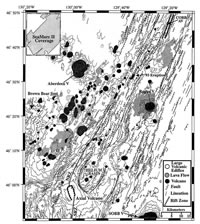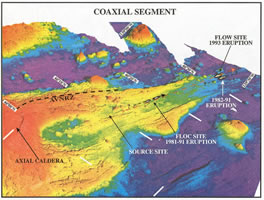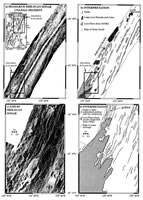U.S. Dept. of Commerce / NOAA / OAR / PMEL
/ Publications
Recent eruptions on the CoAxial segment of the Juan de Fuca Ridge:
Implications for mid-ocean ridge accretion processes
R. W. Embley,1 W. W. Chadwick,2 M. R. Perfit,3
M. C. Smith,3 and J. R. Delaney4
1Pacific Marine Environmental Laboratory, National Oceanic
and Atmospheric Administration, Hatfield Marine Science Center, Newport, Oregon
97365
2Cooperative Institute for Marine Resources Studies, Oregon State
University, Hatfield Marine Science Center, Newport, Oregon 97365
3Department of Geology, University of Florida, Gainesville, Florida,
32611
4School of Oceanography, University of Washington, Seattle, WA 98195
Journal of Geophysical Research, 105(B7),
16,501–16,525 (2000).
Copyright ©2000 by the American Geophysical Union. Further electronic distribution
is not allowed.
3. The Structural and Volcanological Context of the Central Juan de Fuca Ridge
The Juan de Fuca Ridge extends from the Blanco Fracture Zone at 44°30 N
northward to the Sovanco Fracture Zone at 48°45
N
northward to the Sovanco Fracture Zone at 48°45 N
(Figure 1). General descriptions of the ridge
and its various segments have been published previously [Crane
et al., 1985; Delaney
et al., 1981; Embley
and Chadwick, 1994; Embley
et al., 1990; Johnson
and Holmes, 1989; Kappel
and Normark, 1987; Kappel
and Ryan, 1986]. The dominant morphologic feature on the Juan de Fuca
Ridge is the anomalously shallow edifice of Axial Volcano, the youngest in a
series of volcanos generated by the Cobb-Eickelberg hotspot [Desonie
and Duncan, 1990] (Figure 1). The general
characteristics of the Axial Volcano segment have been described by Delaney
et al. [1981], Johnson
and Holmes [1989], Johnson
and Embley [1990], Appelgate
[1990], and Embley
et al. [1990]. The bulk of the volcanic edifice lies between about 45°30
N
(Figure 1). General descriptions of the ridge
and its various segments have been published previously [Crane
et al., 1985; Delaney
et al., 1981; Embley
and Chadwick, 1994; Embley
et al., 1990; Johnson
and Holmes, 1989; Kappel
and Normark, 1987; Kappel
and Ryan, 1986]. The dominant morphologic feature on the Juan de Fuca
Ridge is the anomalously shallow edifice of Axial Volcano, the youngest in a
series of volcanos generated by the Cobb-Eickelberg hotspot [Desonie
and Duncan, 1990] (Figure 1). The general
characteristics of the Axial Volcano segment have been described by Delaney
et al. [1981], Johnson
and Holmes [1989], Johnson
and Embley [1990], Appelgate
[1990], and Embley
et al. [1990]. The bulk of the volcanic edifice lies between about 45°30 N
and 46°20
N
and 46°20 N and consists of a summit
plateau and caldera centered at 45°55
N and consists of a summit
plateau and caldera centered at 45°55 N,
130°00
N,
130°00 W, two major rift zones around
the caldera, and several other smaller plateaus and volcanic rift zones and
ridges (Figures 1 and 2
and Plate 1). Axial Volcano and its major rift
zones probably overlie the spreading axis between the Vance and CoAxial segments
[Delaney
et al., 1981].
W, two major rift zones around
the caldera, and several other smaller plateaus and volcanic rift zones and
ridges (Figures 1 and 2
and Plate 1). Axial Volcano and its major rift
zones probably overlie the spreading axis between the Vance and CoAxial segments
[Delaney
et al., 1981].

Figure 2. Interpretative map of Axial Volcano and CoAxial segment based
on SeaMARC II side-scan sonar and side-lit SeaBeam bathymetry. Dark shaded areas
are major off-axis volcanos, medium shaded zones are high backscatter areas
marking most recent off-axis lava flows, and light shaded zone marks approximate
limit of major hotspot edifices of Axial Volcano and Brown Bear Seamount to
the east. Faults are hachured. SeaBeam contours are lightly shaded and their
limit marks limit of SeaBeam coverage. Coverage of SeaMARC II side-scan sonar
surveys in 1983 and 1984 are shown in inset. SRZ is south rift zone, NRZ is
north rift zone, SOBB is Son of Brown Bear Volcano.

Plate 1. Perspective side-lit SeaBeam bathymetry of CoAxial segment of Juan
de Fuca Ridge with locations of major features discussed in text. View is looking
northwest from eastern side of Axial Volcano. Latitudes and longitudes are only
approximate because of foreshortening of image. Dashed lines with arrows are
orientations and extent of diking based on geologic evidence for 1993 (red)
and 1981–93 dikes.
To better understand the segmentation of the ridge in this complex area, we
constructed a structural map based on the SeaBeam bathymetry and SeaMARC II
side-scan data (Figure 2). In older maps based
on these data [Davis
and Currie, 1993; Johnson
and Holmes, 1989] the Axial Volcano North Rift Zone (AVNRZ) overlaps
with the Cobb segment beginning at about 46°40 N
and what is now known as the CoAxial segment was not recognized as an active
spreading segment. However, the CoAxial segment is clearly delineated as a separate
spreading segment by inward facing faults between 46°00
N
and what is now known as the CoAxial segment was not recognized as an active
spreading segment. However, the CoAxial segment is clearly delineated as a separate
spreading segment by inward facing faults between 46°00 N
and 46°40
N
and 46°40 N (Figures
2, 3a, and 3b). These faults structurally
define an axial valley that is between 3 and 5 km in width with up to 150
m of relief. The southern portion of the CoAxial segment overlaps with the AVNRZ
for at least 25 km (46°00
N (Figures
2, 3a, and 3b). These faults structurally
define an axial valley that is between 3 and 5 km in width with up to 150
m of relief. The southern portion of the CoAxial segment overlaps with the AVNRZ
for at least 25 km (46°00 –15
–15 N),
and the northern end of CoAxial segment overlaps with the southern portion
of the Cobb segment by 10 km. The southern end of the CoAxial valley was named
"Helium Basin" because of the unusually high
N),
and the northern end of CoAxial segment overlaps with the southern portion
of the Cobb segment by 10 km. The southern end of the CoAxial valley was named
"Helium Basin" because of the unusually high  (
( He)%
found in hydrothermal plumes from this area in the early 1980s [Lupton,
1990].
He)%
found in hydrothermal plumes from this area in the early 1980s [Lupton,
1990].
Most of the faults digitized from the SeaMARC II and SeaBeam data are oriented
at or close to the trend of the Juan de Fuca Ridge (~N020°E), but oblique
or curvilinear ridges occur at several locations. Curvilinear constructional
volcanic ridges occur on the eastern side of the AVNRZ and at the southern and
northern ends of the CoAxial segment where it overlaps with the AVNRZ and the
Cobb segment, respectively. These curvilinear ridges are interpreted to be formed
by crack interaction between overlapping spreading segments such as those described
at faster spreading centers [Macdonald
and Fox, 1983; Sempere
and Macdonald, 1986]. A set of oblique ridges on older crust found northeast
of Axial Volcano (Figure 2) could be traces of
an older overlapping zone.
A striking feature in Figure 2 is the asymmetric
distribution of volcanic cones and lava flows on the west side of the ridge
and the concomitant apparent lack of faulting. Sediment cover is thinner on
the west side of the ridge because the ridge blocks the sediments from the continent,
so this asymmetry in faulting is not caused by sediment cover. It is probably
due either to burial of the faults by more active off-axis volcanism and/or
because faulting has been less developed on the west side, possibly due to the
shoaling of isotherms in the vicinity of the hotspot. Although there are a few
large volcanoes on the east flank of the ridge axis, most of the recent off-axis
lava flows are confined to the flank of Axial Volcano and Rogue Volcano. An
exception is one isolated but well-defined off-axis lava flow at 46°40 N,
129°20
N,
129°20 W (Figure
2).
W (Figure
2).

Figure 3. (a) Sea MARC II swath of Coaxial segment and (b) interpretation.
Note distinct graben containing northernmost young lavas. (c) AMS-60 side-scan
mosaic of junction of AVNRZ and CoAxial axial valley and (d) interpretation.
Note high backscatter lavas erupted along AVNRZ covering older (lower backscatter)
fissured lavas.
Return to previous section or go to next
section
PMEL Outstanding Papers
PMEL Publications Search
PMEL Homepage
 N
northward to the Sovanco Fracture Zone at 48°45
N
northward to the Sovanco Fracture Zone at 48°45 N
(Figure 1). General descriptions of the ridge
and its various segments have been published previously [Crane
et al., 1985; Delaney
et al., 1981; Embley
and Chadwick, 1994; Embley
et al., 1990; Johnson
and Holmes, 1989; Kappel
and Normark, 1987; Kappel
and Ryan, 1986]. The dominant morphologic feature on the Juan de Fuca
Ridge is the anomalously shallow edifice of Axial Volcano, the youngest in a
series of volcanos generated by the Cobb-Eickelberg hotspot [Desonie
and Duncan, 1990] (Figure 1). The general
characteristics of the Axial Volcano segment have been described by Delaney
et al. [1981], Johnson
and Holmes [1989], Johnson
and Embley [1990], Appelgate
[1990], and Embley
et al. [1990]. The bulk of the volcanic edifice lies between about 45°30
N
(Figure 1). General descriptions of the ridge
and its various segments have been published previously [Crane
et al., 1985; Delaney
et al., 1981; Embley
and Chadwick, 1994; Embley
et al., 1990; Johnson
and Holmes, 1989; Kappel
and Normark, 1987; Kappel
and Ryan, 1986]. The dominant morphologic feature on the Juan de Fuca
Ridge is the anomalously shallow edifice of Axial Volcano, the youngest in a
series of volcanos generated by the Cobb-Eickelberg hotspot [Desonie
and Duncan, 1990] (Figure 1). The general
characteristics of the Axial Volcano segment have been described by Delaney
et al. [1981], Johnson
and Holmes [1989], Johnson
and Embley [1990], Appelgate
[1990], and Embley
et al. [1990]. The bulk of the volcanic edifice lies between about 45°30 N
and 46°20
N
and 46°20 N and consists of a summit
plateau and caldera centered at 45°55
N and consists of a summit
plateau and caldera centered at 45°55 N,
130°00
N,
130°00 W, two major rift zones around
the caldera, and several other smaller plateaus and volcanic rift zones and
ridges (Figures 1 and 2
and Plate 1). Axial Volcano and its major rift
zones probably overlie the spreading axis between the Vance and CoAxial segments
[Delaney
et al., 1981].
W, two major rift zones around
the caldera, and several other smaller plateaus and volcanic rift zones and
ridges (Figures 1 and 2
and Plate 1). Axial Volcano and its major rift
zones probably overlie the spreading axis between the Vance and CoAxial segments
[Delaney
et al., 1981].


 (
( He)%
found in hydrothermal plumes from this area in the early 1980s [
He)%
found in hydrothermal plumes from this area in the early 1980s [